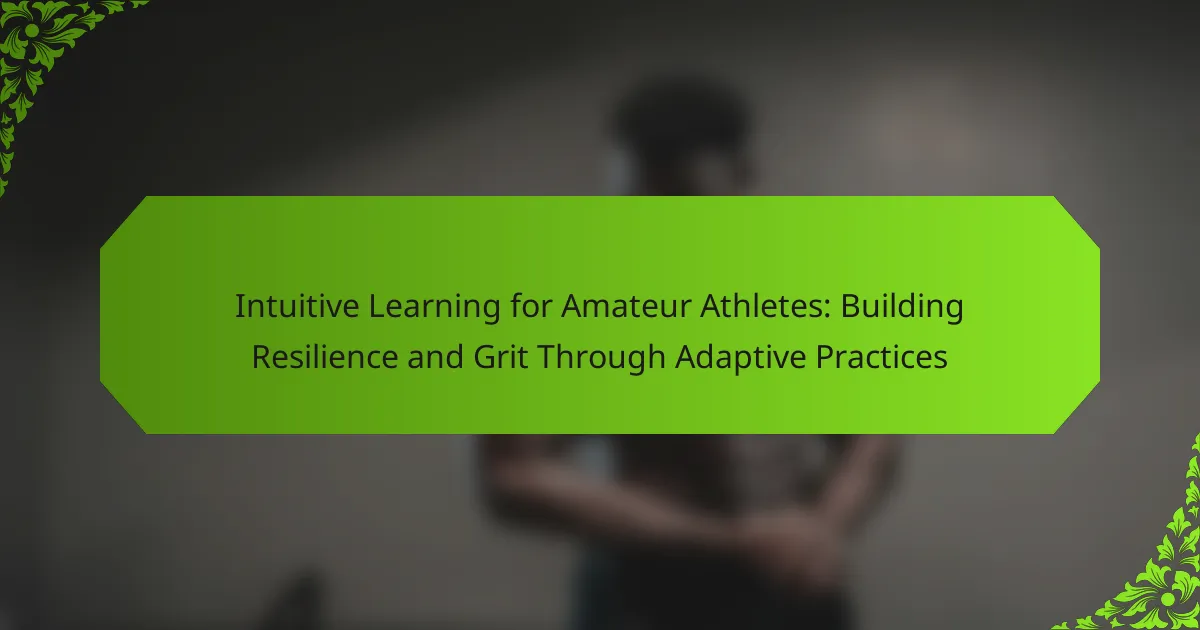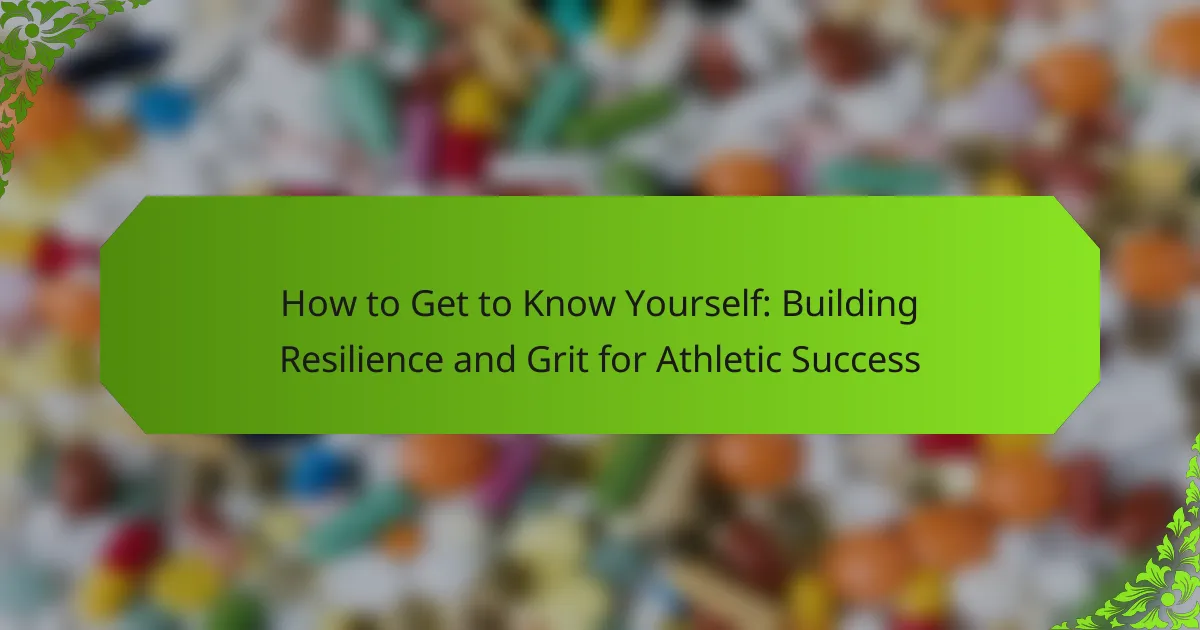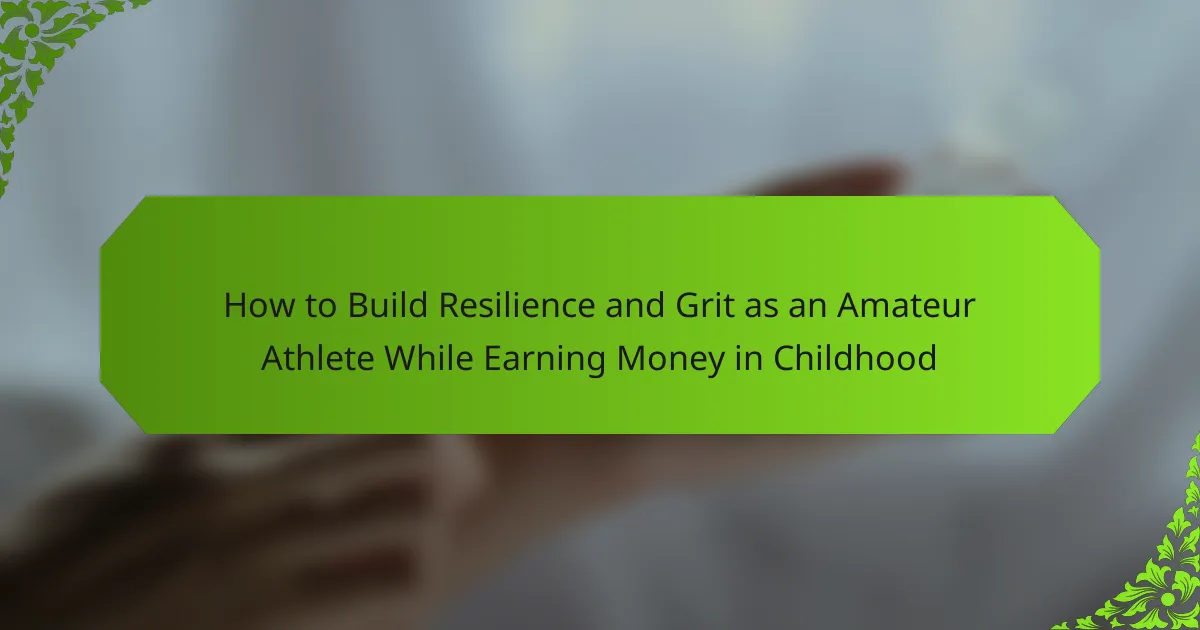Building grit is essential for amateur athletes facing challenges in their sports journey. Highly intuitive resilience techniques enhance mental toughness, emotional regulation, and focus. Key practices include visualization, goal-setting, and positive self-talk. These strategies collectively foster perseverance and resilience, vital for improved performance and overcoming setbacks.

What are Highly Intuitive Resilience Techniques?
Highly Intuitive Resilience Techniques enhance grit in amateur athletes through adaptive mental strategies. These techniques focus on emotional regulation, visualization, and positive self-talk. Emotional regulation helps athletes manage stress and maintain focus during competitions. Visualization allows them to mentally rehearse performances, improving confidence and reducing anxiety. Positive self-talk reinforces a growth mindset, fostering perseverance and resilience. Together, these techniques create a robust framework for building grit, essential for overcoming challenges in sports.
How do these techniques differ from traditional methods?
Highly intuitive resilience techniques focus on mental adaptability and emotional regulation, unlike traditional methods that often emphasize physical training and rigid routines. These techniques encourage a holistic approach, fostering personal growth and self-awareness. For example, while traditional methods may rely on repetitive drills, intuitive techniques promote creative problem-solving and flexibility in challenging situations. This shift enhances grit by empowering amateur athletes to navigate setbacks with resilience rather than solely relying on physical prowess.
What role does emotional intelligence play in resilience?
Emotional intelligence significantly enhances resilience by enabling athletes to manage stress and adapt to challenges. High emotional intelligence fosters self-awareness, allowing athletes to recognize their emotions and reactions during high-pressure situations. This awareness leads to better emotional regulation, which is crucial for maintaining focus and composure. Additionally, emotionally intelligent athletes can empathize with teammates, creating supportive environments that encourage grit and perseverance. As a result, they are better equipped to bounce back from setbacks, enhancing their overall performance and mental fortitude.

What are the universal attributes of resilience techniques for amateur athletes?
Highly intuitive resilience techniques for amateur athletes focus on adaptability, mental toughness, and emotional regulation. Key attributes include visualization, goal-setting, and positive self-talk. These techniques enhance grit and perseverance, vital for overcoming challenges. Research indicates that consistent practice of these methods improves performance and reduces anxiety. Engaging in mindfulness can also foster resilience, allowing athletes to remain focused under pressure.
How can visualization enhance resilience and grit?
Visualization significantly enhances resilience and grit by fostering mental fortitude in amateur athletes. It allows them to mentally rehearse challenges, boosting confidence and focus. This technique strengthens the neural pathways associated with perseverance, enabling athletes to better handle setbacks. Research indicates that athletes who practice visualization show improved performance and increased resilience in high-pressure situations. By creating vivid mental images of success, they can cultivate a growth mindset, which is essential for developing grit.
What benefits do positive affirmations provide?
Positive affirmations enhance mental resilience, boost self-confidence, and foster a growth mindset in amateur athletes. They encourage a positive self-image, leading to improved performance under pressure. Regular practice can reduce anxiety and increase motivation, creating a more focused and determined athlete. As a result, athletes develop grit, crucial for overcoming challenges and achieving goals.
How does goal setting contribute to building grit?
Goal setting enhances grit by providing clear objectives and a roadmap for perseverance. It fosters commitment and resilience, essential traits for amateur athletes facing challenges. Setting specific, measurable goals helps athletes track progress, reinforcing their determination. Research indicates that goal-oriented individuals exhibit higher levels of grit, as they are more likely to overcome obstacles and maintain focus. This intrinsic motivation drives continuous improvement and fosters a growth mindset, crucial for long-term success in sports.
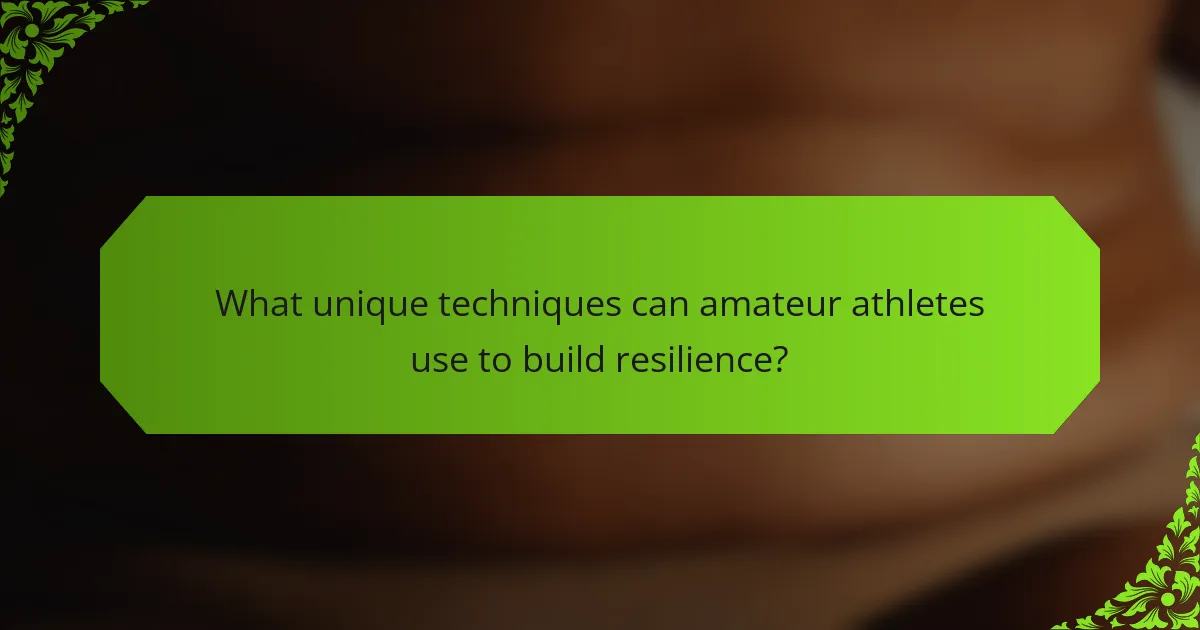
What unique techniques can amateur athletes use to build resilience?
Amateur athletes can build resilience using unique techniques such as visualization, mindfulness, and goal-setting. Visualization helps athletes mentally rehearse success, enhancing confidence and focus. Mindfulness practices improve awareness and stress management, fostering emotional stability. Goal-setting instills a sense of purpose, motivating athletes to overcome challenges. These techniques collectively enhance grit, a critical attribute for sustained performance.
How can storytelling foster a growth mindset?
Storytelling can significantly foster a growth mindset by illustrating resilience and adaptability. Through narratives, amateur athletes can see real-life examples of overcoming challenges, which reinforces the belief that effort leads to improvement. This perspective encourages them to embrace setbacks as learning opportunities, thereby developing grit. Engaging stories can also build emotional connections, motivating athletes to persist despite difficulties. Ultimately, storytelling serves as a powerful tool to cultivate a mindset focused on growth and perseverance.
What is the impact of peer support on resilience?
Peer support significantly enhances resilience in amateur athletes by fostering a sense of belonging and shared experience. This connection leads to improved mental toughness and grit, essential for overcoming challenges. Studies indicate that athletes with strong peer networks exhibit higher levels of motivation and lower stress, contributing to better performance outcomes. Engaging in supportive relationships also promotes emotional regulation, allowing athletes to navigate setbacks more effectively.
How can adaptive thinking improve performance under pressure?
Adaptive thinking enhances performance under pressure by enabling athletes to adjust their strategies dynamically. This flexibility fosters resilience, allowing for quicker recovery from setbacks. Research indicates that athletes employing adaptive thinking demonstrate improved focus and decision-making during high-stress situations, leading to better overall performance. Integrating techniques like visualization and mindfulness can further strengthen this adaptive mindset, enhancing grit and perseverance in amateur athletes.
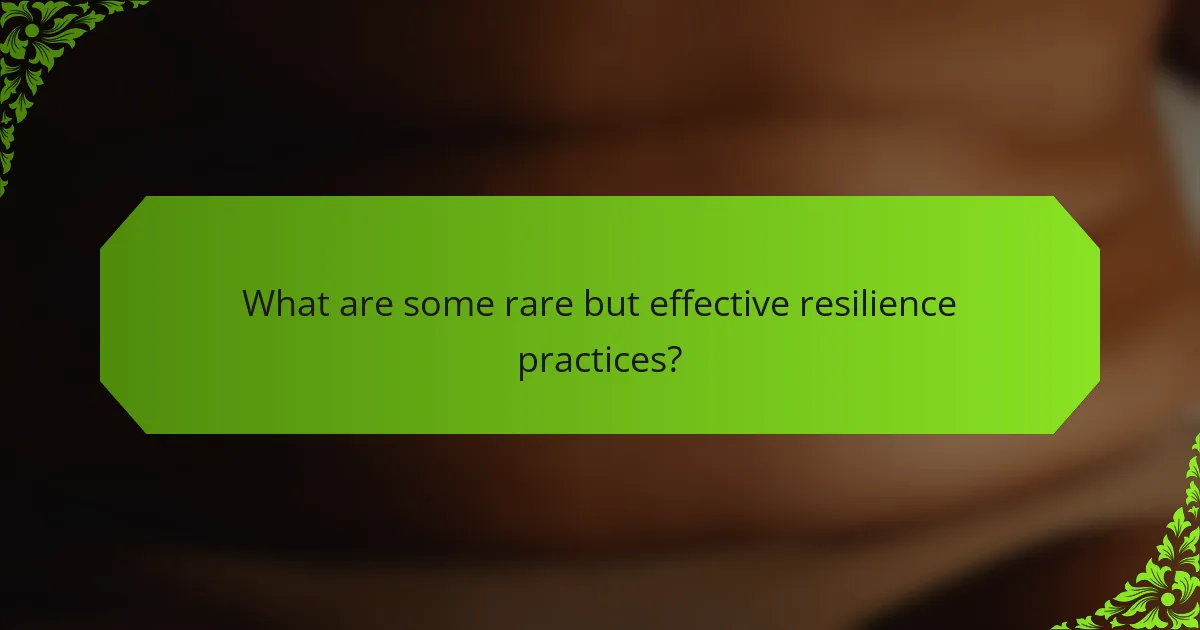
What are some rare but effective resilience practices?
Highly intuitive resilience techniques include visualization, mindfulness, and adaptive goal-setting. These practices enhance mental toughness in amateur athletes. Visualization helps athletes mentally rehearse performance, improving focus and reducing anxiety. Mindfulness fosters present-moment awareness, which can decrease stress and enhance emotional regulation. Adaptive goal-setting encourages flexibility, allowing athletes to adjust their objectives based on performance feedback, thus promoting persistence. Each technique uniquely contributes to building grit and resilience, essential qualities for athletic success.
How can art and creativity enhance emotional resilience?
Art and creativity significantly enhance emotional resilience by fostering self-expression and coping mechanisms. Engaging in creative activities allows amateur athletes to process emotions constructively, reducing stress and anxiety. This unique attribute of creativity enables individuals to build grit by encouraging problem-solving skills and adaptability. As a result, athletes develop a stronger mental framework, improving their performance and overall well-being.
What role does nature play in building grit?
Nature plays a crucial role in building grit by providing environments that foster resilience. Exposure to natural settings enhances mental well-being, reducing stress and anxiety, which are barriers to perseverance. Engaging in outdoor activities promotes physical health, encouraging a mindset of challenge and growth. Additionally, the unpredictability of nature teaches athletes to adapt and overcome obstacles, reinforcing their grit. Studies show that regular interaction with nature can increase motivation and commitment, vital attributes for amateur athletes seeking to develop resilience.

How can amateur athletes implement these techniques in their training?
Amateur athletes can implement highly intuitive resilience techniques by incorporating mental visualization, goal setting, and adaptive training methods. These techniques build grit and enhance performance.
1. Mental Visualization: Athletes should visualize successful outcomes during training sessions. This practice reinforces confidence and prepares the mind for competition.
2. Goal Setting: Establishing specific, measurable, achievable, relevant, and time-bound (SMART) goals helps athletes focus their efforts and track progress effectively.
3. Adaptive Training: Athletes should regularly assess their training routines and modify them based on performance feedback. This adaptability fosters resilience and encourages growth.
4. Positive Self-Talk: Encouraging self-dialogue can boost motivation and help athletes overcome challenges during training.
By consistently applying these techniques, amateur athletes can significantly enhance their resilience and overall athletic performance.
What are the best practices for integrating resilience training?
To effectively integrate resilience training, focus on tailored techniques that enhance mental toughness in amateur athletes. Start by assessing individual needs to create personalized training plans. Incorporate diverse methods such as visualization, goal-setting, and mindfulness to build grit. Regularly evaluate progress and adjust strategies based on feedback. Foster a supportive environment that encourages open communication and resilience practice.
What common mistakes should athletes avoid when building grit?
Athletes should avoid common mistakes like setting unrealistic goals, neglecting recovery, and ignoring mental training. These pitfalls hinder grit development. Unrealistic goals can lead to frustration and burnout. Recovery is essential for physical and mental resilience. Mental training techniques, such as visualization and positive self-talk, are crucial but often overlooked.

What expert insights can guide amateur athletes in their resilience journey?
Amateur athletes can enhance their resilience by adopting highly intuitive techniques that build grit. Focus on mindset, goal-setting, and consistent practice.
1. Embrace a growth mindset: View challenges as opportunities for learning and improvement.
2. Set specific, measurable goals: Break down larger objectives into achievable steps to maintain motivation.
3. Develop a supportive community: Surround yourself with like-minded individuals who encourage perseverance.
4. Practice mindfulness: Engage in techniques like meditation to enhance focus and emotional regulation.
These strategies foster resilience, helping athletes navigate setbacks effectively.
How can coaches support athletes in developing resilience?
Coaches can support athletes in developing resilience by implementing intuitive techniques that foster grit. These techniques include setting achievable goals, promoting a growth mindset, and encouraging self-reflection.
Setting achievable goals helps athletes focus on incremental progress, which builds confidence and determination. A growth mindset allows athletes to view challenges as opportunities for learning, enhancing their ability to bounce back from setbacks. Encouraging self-reflection enables athletes to analyze their experiences, fostering a deeper understanding of their strengths and areas for improvement.
Incorporating team-building activities also strengthens resilience by creating a supportive environment. Athletes learn to rely on each other, which cultivates camaraderie and collective grit. Coaches should regularly communicate the importance of perseverance, reinforcing the idea that resilience is a skill that can be developed over time.
These strategies emphasize emotional intelligence and adaptability, crucial attributes for athletes facing competitive pressures. By focusing on these highly intuitive resilience techniques, coaches can effectively nurture grit in amateur athletes.
What are the top tips for sustaining resilience over time?
To sustain resilience over time, amateur athletes should adopt consistent mental and physical practices. Establishing a routine that includes goal-setting, mindfulness, and regular feedback enhances grit. Incorporating social support and focusing on personal growth helps maintain motivation. Engaging in reflective practices fosters self-awareness, allowing for adaptation to challenges.
